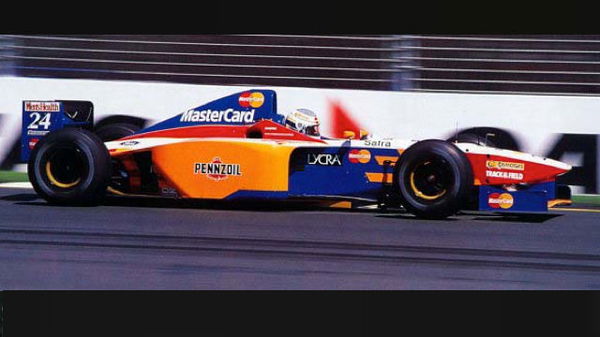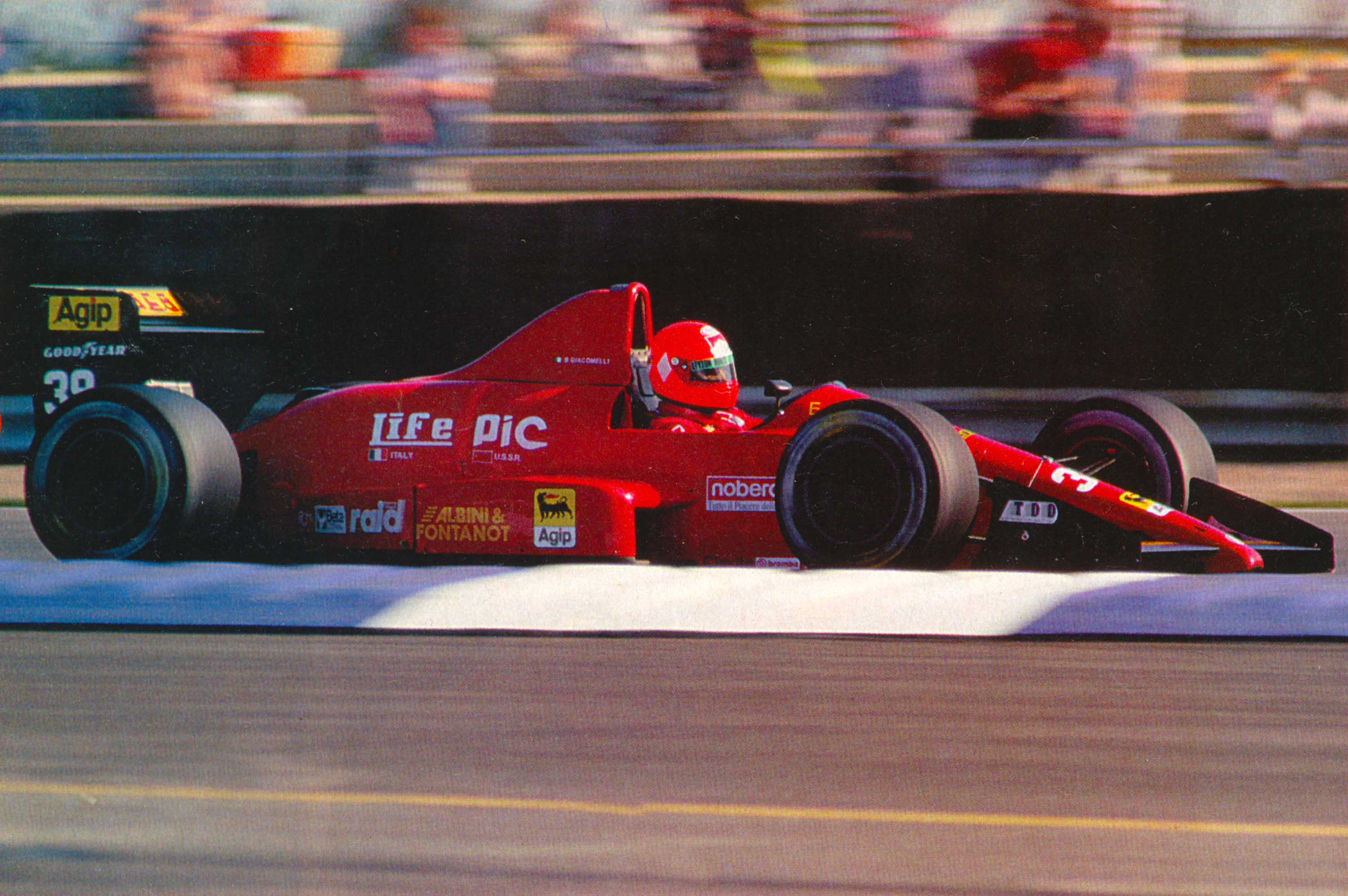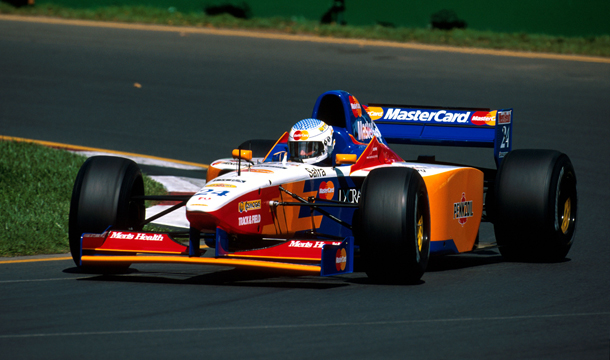

Any debate regarding the best F1 teams will always bring out different opinions and cause arguments. Some teams are forgotten, some underestimated and some overestimated, and normally a partisan fight ensues. But you can be sure that the same happens when the discussion revolves around the worst teams. It is almost sure that not everybody will agree with the names, even more so when you have more candidates than places on a list. So to create a list of the 10 worst F1 teams ever, the following names sprung into mind, with the reasons explained.
Life
ADVERTISEMENT
Article continues below this ad

It all started with a chassis that should mark First Motorsport’s – then a force in F-3000 – first foray into F-1. Lamberto Leoni’s squad plans didn’t go into fruition but, with a Judd V8 (as it should be) at its back, the car could have played a decent role in other hands. The obvious choice wasn’t the one that Ernesto Vita used with his team.
Former Ferrari engineer Franco Rocchi had a W12 ready to use – think about a V8 with an inline four in the middle at that time (1990) . Even at the dyno, it showed some promise, but was really tested in the GPs, with the late Gary Brabham as the chosen driver. The combination never worked, in a year that even pre-qualifying was necessary to define the 30 cars that would fight for the 26 positions on the grid.
To make the F190 complete one whole lap was already a feat and, when it did, rivals were no less than 15 seconds ahead. Disastrous and shameful for poor Jack Brabham’s son, enough was enough and not even a Russian capital injection (the car even had the Mig badge, from the aircraft fighters factory) could bring a solution. The car was slower than the F-3 cars that raced on the same weekend in Monaco. While, reluctantly, Vita decided to scrap the W12 engine for a more reliable Judd V8 in Spain and Portugal, the efforts were to no avail.
Andrea Moda

Not that the Coloni squad was a force to be reckoned with, but the effort of Enzo Coloni was, at least, planned and serious, and helped to launch drivers like Gabriele Tarquini. But when he decided to leave, the remnants of the team were bought by Andrea Sassetti – a man who was good at the art of creating shoes, but managing a F1 team was not his forte. In 1992 the team arrived in South Africa with boxes full of parts, but not a car (and that was still the old Coloni one).
A political fight ensued, as FIA determined that, as a new team, Andrea Moda had to pay the US$ 100,000 tax and only run his own model, which wasn’t ready then. The same situation ensued in Mexico and the originally committed pair of Alex Caffi and Enrico Bertaggia was dropped. Replacing them were Roberto Moreno and Perry Mccarthy.
A new chassis, with Judd V10 power, was committed to Nick Wirth and was ready by Interlagos, the third Grand Prix of the season, when poor Moreno almost had the chance of completing a lap. Perry McCarthy, however, could only see that from the boxes. Then, came Monaco and the “super sub” Roberto Moreno. He used to shine even with poor equipment, and made the miracle of going ahead of pre-qualifying and putting the S921 on the grid.
He started dead last and was running as high as 19th, only to abandon the race on lap 11. At least the Italian squad would have a GP start on its rostrum. With little spare parts and no budget at all, hard reality ensued and the car was never again near the Brazilian’s feat. McCarthy hardly had the chance to complete some laps and the chaotic situation continued until Belgium. Sassetti was put in jail by local authorities due to financial concerns, and the team was expelled by the FIA so as not to be detrimental to the sport’s image.
Eifelland

If one looks today at the Mercedes dominance, one will hardly believe that the German strength in Formula 1 wasn’t nowhere near this when the Silver Arrows left the grid following their first guise, following the Le Mans tragedy that year. Teams and drivers hadn’t tasted success – Wolfgang Von Trips was an exception – but projects were many. Among them, one was started by businessman Günther Hennerici, who saw motor racing as a good platform to advertise his caravan factory, in 1972. He could just buy a March 721, as it was allowed at the time, and put it on the track, but decided to do more.
He brought in designer Luigi Colani to improve the package, which he tried to do, but ended up creating one of the ugliest F1 machines ever. The car had a huge air intake on the nose, and a single mounted rear view mirror, placed in the middle. It at least worked, no problem, but it lacked terribly on down-force and had set up problems. Although he was a very fast driver, Rolf Stommelen could do little to improve things, and it was decided to dump the in-house design to bet on the original March project. Eight races and a couple of 10th places were the length of the adventure for Hennerici.
Forti Corse

At some point in motor racing, it was just like football: you started in the lower divisions and, once strong enough, tried to play your way to the top. Especially in Britain and Italy it proved to be true and one of those cases was Forti Corse’s. Guido Forti’s team had quite a decent rostrum on F-3 and F-3000, and in 1995, with a good sponsor support provided by Brazilian supermarket tycoon Abilio Diniz, father of Pedro Paulo Diniz, they decided that it was time to climb the last mountain. The chassis was a rewriting of the project for the now defunct Fondmetal 1993 car. Being designed almost like a puzzle – one gave input here, the other there, and with an under-powered Ford ED V8, it raised no eyebrows.
It was heavy and very slow indeed. And if one takes a look at some of the results and finds some seventh, ninth or tenth places (Diniz and Roberto Moreno were the drivers), they were laps and laps behind the leaders. There was a huge effort to make the car more competitive, but to little avail. For 1996, Forti and engineer Paolo Guerci hired some competent people to the team, but Diniz decided to leave for Ligier and took all sponsors with him.
Plans to bring in a new chassis and a powerful Ford engine were halted by then. Andrea Montermini and Luca Badoer were drafted and, after the latter flipped in Argentina (touched by… Diniz), a new chassis, the FG03 was produced, which gave some hope. But… a war with Shannon Racing, an investment entity that had to own 51% of the team, ensued, and money became scarce. The team story ended after the Hungarian GP.
Lola

In 1997, one could never image that a traditional racing car producer that spanned their creatures from F-3 to world sports cars and Indy cars could be a part of tremendous fiasco trying to return to F1 – they designed and ran the Beatrice and Larrousse cars in the eighties. Especially considering that they had a global sponsor which made the adventure even more credible: MasterCard. They should have been a force to be reckoned with, no doubt at all.
Primary plans were to start only in 1998, as the other series commitments were proving to be huge, but pressure from the PR guys made all the effort being brought one year ahead, which would lay the foundations for the disaster. Originally the car was to be powered by a V10 developed by Al Melling, but delays on testing and development made necessary the change for a no more state-of-the-art Ford Zetec V8. With only five months available, the T97/30 was designed by the Eric Broadley team without any wind tunnel test to its name.
It was, somehow, an F-Nippon chassis on steroids, and only a brief shakedown preceded the real debut, in Australia. The drivers’ duo was, to say the least, a huge guess – if Vincenzo Sospiri was a gifted youngster, Ricardo Rosset was better known by the amount of personal sponsoring he had. With lap times up to 12 seconds higher than the pole, they were denied the chance of being on the grid by the 107% rule. The same story followed in Brazil and, among the shame and the little chances of a rehearsal, MasterCard decided to pull the plug. It would prove to be too much even to Lola, that went bankrupt weeks later.
Hispania/HRT

FIA president Max Mosley opened a place to three new teams in 2010, irritated by the crescent expenditure numbers on the circuit and the factory up’s and go’s. The condition was that as long as they could restrict their budget to US$40 million per year, they could participate. While the amount may seem too much for you and me, it was too little for the F1 demands of the time.
Even then, three outfits presented themselves (one of those, the ill-fated USF1 was almost a joke, later replaced by Lotus/Caterham). The other two were Virgin (Later Marussia and then Manor) and Hispania. The latter was born as an alliance between former race driver Adrián Campos and the businessman Alejandro Agag (the man behind Formula E success), but neither one, stayed on board when it was confirmed. That being so, the car, with Cosworth power, had no down-force at all, and soon it became apparent that the three novices would fight each other and nothing more.
It was as if F1 had a second-tier class, even though they had drivers like Pedro de la Rosa, Bruno Senna and Daniel Ricciardo, who would prove their talent elsewhere or had already done so. In three years, changes on the cars were little, spare parts were scarce and there were no updates at all. Come 2012 and the only hope from José Ramón Carabante, the then owner, was to sell the outfit to some Arabic investors who never came. HRT closed its doors with a 15th place as the best result.
Kauhsen

Before the Concorde Agreement and the rigid rules concerning participation in F-1, almost anyone could try to join it, in almost anything with four wheels and an engine (well, quite). The 1970 decade was even more prodigal, as Ford Cosworth’s were cheap, reliable and competitive. With a decent chassis and good hands at the wheel, the sky was the limit.
In 1979, German Willi Kaasen, with F2 experience, gave the green light to his dream and started production of Kaasen WK, designed by Klaus Kapitsa. With promising Italian Gianfranco Bran Catelli on the seat (one that later would become a touring car legend), Kauhsen showed at the Spanish GP, in Jarawa, but didn’t qualify. The same fate happened in Belgium, after a huge effort to make the car more competitive. The enormous career of the Kauhsen team lasted two races, but the car had a new life, after being sold to Arturo Merzario, who would create his own team. Not that it was more successful, though.
Pacific

During the first years of the 1990 decade, many outfits tried to jump to F-1 after tasting success in lower categories. Not only were the Cosworth engines still available, options like Judd and Ilmor appeared, which made the dream closer. That was the thought of already experienced Briton manager Keith Wiggins – confident from his nice performances in F-3000.
He decided to give it a go in the 1994 season, one that will be always be sadly remembered. And with Frank Coppuck, the son of McLaren legend designer Gordon Coppuck, he had a good base to start with. The original plan was to use a project started by Adrian Reynard, but that was sold to Ligier and only some former Reynard technicians joined and tried to make their own creature, which used many F-3000 components and solutions. They opted for a cautious approach, with a bulky machine, the PR01, moved by an Ilmor V10 that could guarantee at least decent speeds.
The problem was that, by not having a hefty budget, they needed to rely on a noncompetitive duo. One being Bertrand Gachot who started well on the circuit, but became more remembered as the one that opened the chance for Michael Schumacher to debut, after fighting a taxi driver in London. And the second being Paul Belmondo, although a decent driver, he was not up to the challenge. But they were ready to race – or at least try to.
At their first season, Pacific reached a milestone that must not have left the team proud: on the only seven starts of the duo, the car never saw the chequered flag. So, they had only DNQs and DNFs at the chart. For a structure that had, among its drivers, Eddie Irvine, Allan McNish, David Coulthard, Christian Fittipaldi, Cristiano da Matta and the Gené brothers, it was a pity. And not one of them could draft, as money was still scarce.
On year two, with a chassis, the PR02, was somehow improved and received a Ford V8 engine. Andrea Montermini was a nice choice as he had talent and sponsors, but the other car was shared by a totally noncompetitive Jean-Deniz Deletraz and Giovanni Lavaggi, after another brief Gachot spell. At least it was possible to end races and, with good results. Two eighth spots and a ninth place finish would even mean points now, but back then it was only just so close, and insufficient to keep the team racing, so it folded after the season. And Wiggins went stateside, having some more success running Indy car programs.
Maki

When you think on Japan and F-1, one thing that comes to mind is expertise, although even a giant like Honda had problems establishing itself after tasting the waters in the sixties and returned with a fantastic partnership with McLaren, in the eighties. But Kenji Mimura thought he could fight the big boys on the circuit in 1974 and leave the land of the rising sun with pride, creating a machine, the Maki F101 that was aerodynamically strange and bulky.
Neverteheless, at least it relied on a Cosworth DFV V8, which would guarantee some miles. And the driver chosen to command it was the already recognised kiwi Howden Ganley. He was in the cockpit at Brands Hatch to try to qualify it, but couldn’t. The same occurred later in Germany, where a crash even injured his legs seriously. Mimura decided to bring the car back to Tokyo, trying to develop it to return in better conditions the year after. He tried, with a nice sponsorship (Citizen Watches) but a Nippon driver, Hiroshi Fushida, with little experience on the European tracks.
And, then, in France, with only 25 starters, a place on the grid was guaranteed… only for the engine to malfunction during the practice and leave the team with empty hands, as a replacement was not available. Fushida tried again in Great Britain, this time with a DNQ. And in came paddler Tony Trimmer, who used to be fast on almost anything with wheels and had nice results on the unofficial F-1 races, but his fate was the same, with three DNQs. And in 1976, at the Japanese Grand Prix that handled James Hunt his title, not without controversy with Niki Lauda, as the car had returned to Japan, Mimura tried to field it one last time, again with Trimmer. But it did not start a race even at home. There was no more Maki after that.
Token
ADVERTISEMENT
Article continues below this ad

One could not imagine that a team that had Ron Dennis as one of the starters would figure out on this list, but it might be explained. In 1973, Dennis and Neil Trundle had the Rondel F2 team, and thought they could go further, committing Ray Jessop to design a car that would receive a Cosworth V8, only to change. French oil company Motul should have funded the team, but pulled the plug with the onset of the global oil crisis. Then the outfit was sold to businessmen Tony Vlassopoulo and Ken Grob, hence the name joining their initials: Token.
ADVERTISEMENT
Article continues below this ad
That the base was good was confirmed when the team’s driver Tom Pryce managed to qualify the car at a decent 20th spot on Belgium GP, only to abandon with a crash. And as he decided to join Shadow, David Purley was brought for a second try, at home (British GP), but, this time, could not qualify. That was that for him, and a third driver joined in that very year: Ian Ashley, who fought the green hell of Nurburgring with more than what was expected, not only qualifying, but also running as high as eight, before mechanical problems side-lined him.
Another try in Austria, another start, and another DNF. By that time, Vlassopoulo and Grab were already sure that they had not the necessary money to continue (one could say that tokens were no more available then). So the RJ02 was sold to Safir Engineering, which fielded it on some British F-1 meetings as Race of Champions and the BRDC International Trophy. THis i
ADVERTISEMENT
ADVERTISEMENT
ADVERTISEMENT
ADVERTISEMENT

